|
Articles
ARCHITECTURE IN CYBERSPACE OR
CYBERSPACE IN ARCHITECTURE?
A Study into Cyber Technology, Cyber Culture and the Impacts on Man
at the Turn of the Millennium
Paper by
Yang Li
National University of Singapore
Section 2
3.0
RECONFIGURING ARCHITECTURE
As we are being morphed into cyborgs, the space we inhabit, the
buildings and the entire urban environment are also transforming.
Circulation systems are being replaced by telecommunication systems.
Traditional building types become obsolete. Office floors raised,
old copper wires dug up and replaced by fibre optical cables, as catalogue
shelves in libraries are replaced by computer terminals and so on.
Traditionally, architecture played an important role in organising
the functions and relationship between activities. Landscape affects
the interaction between spaces. For instance, the Berlin wall was
a dividing line between the East and the West. To get money from a
bank 20 years ago, one will have to travel physically to the bank.
To give a guest lecture, one has to travel and even fly for almost
a day. There is a close relationship between the physical environment
and us. As Winston Churchill once pointed out "We make our buildings
and our buildings make us."
Today, spaces in general are being taken up by telecommunication
and computer systems. Book shelves and catalogue shelves are filled
with computer disks and CD-ROMs. The digital, electronic, virtual
side is increasingly taking over the physical. Instead of flipping
through a thick dictionary, one would rather use the MS Word 7.0 spelling,
thesaurus and grammar check. To transfer cash from bank to bank, I
could do it through the telephone, which is much faster than signing
a check and depositing it through an ATM machine.
Although book stores can be replaced by bit store, museum reading
rooms and library stacks and catalogues replaced by servers, galleries
replaced by virtual museum, theatre replaced by entertainment infrastructures,
schools replaced by virtual campuses, it is not happened yet. The
idea was not new, back in the 1980s, Alvin Toffler has already written
it in "The Electronic Cottage" . The success of technology
is flawed when it does not address the social issue about this kind
of living. The extreme end of cyber technology is isolation. Isolation
as been clearly illustrated in E.M. Foster's "The machine stops"
It is a time where there is no desire to touch or feel another human
being, a time when the physical element is “boring” and
reinterpretations of what is considered “interesting” and
reinterpretations of the interpreted are considered “even more
interesting”. A time whereby information is paramount and physical
form redundant.
Unless the society has been transformed so drastically, social aspects
became so differently, only then, will architecture become obsolete.
3.1 Recombining Architecture
Efficient delivery of bits into domestic space will collapse many
of the spatial and temporal separations of activities. Many activities
could be done at one location. Diffusing the boundary between workplaces
and working hours, theatres and performance times, at home and at
one’s own time. The switch time between different activities
becomes almost immediate. Free time and work time become flexible
and interchangeable.
The perception of spaces differs because the functions of these spaces
are now combined. The living room with the screen will become a work
place, an entertainment space and a recreational space, all of which
could be controlled by opening up windows by a simple click.
All these instabilities and ambiguities in space also challenged
traditional ways of representing social distinctions and stages of
socialisation. Especially in societies where there are well-defined
spaces for different activities, for men and women, for family members
and guests, for adults and adolescents. On the urban scale, there
is a separation between quiet space for academic activities and noisy
place for jam sessions and performances, for the rich and poor, sacred
place and common areas, restricted areas and public areas. These spaces
lost their identity in cyberspace.
The definition and description of these spaces will change. Access
to these places will become almost immediate. Spaces thus become defined
by the availability of equipment. Whether is it a 686, pentium 586
or 486 and at what frequency and how many megabytes of RAM, what kind
of telecommunication network, normal copper wire phone line or ISDN
optical fibre connection? Is there a video capturing device for teleconferencing
and a virtual goggle to experience a 3-Dimensional effect? Is there
a high speed printer that can generate copies of documents? Is there
colour print out and the size of the print out also matters?
In a space without these telecommunication and transportation facilities,
a telecommuter will certainly feel paralysed for a long period of
time.
Telecommuters need not work in downtown offices but the computer
mainframe needs to be serviced and maintained or even repaired in
the quickest time, downtown offices may thus be filled up with computer
mainframes and with super high speed gateways to suburban regional
centres. There will also be small teams with highly trained engineers
and technicians who will be stationed at centralised location attending
to the computer systems in a few nearby buildings.
3.2 Programmable Places
For other building types, the story is much the same except some
change of use. The function and circulation of the original spaces
will not change drastically. When we enter a library to look for the
physical embodiment of knowledge, the book, the process is still the
same although it could also be available on an electronic webpage.
Viewing something virtually will not completely erase the need to
see the real thing. It will only decrease the number of visitors visiting
physically and increasing the number of virtual visitors. Just look
at the main page with the counter and imagine how many visitors less
would there be if it is on a bounded copy alone.
When it is possible to substitute face to face contact most of the
time, the spatial linkages for these activities loosen, they can potentially
relocate and recombine in new logics. Perhaps we will find compelling
advantages in putting together spaces. A certain group that is on
this side is the Eco-conscious group, like what they said, "Just
look at the amount of petrol saved". In any case, old bonds break
and new bonds will form.
Buildings nowadays not only have to relate to the urban context but
also to the cyber context. Instead of huge roller coaster rails, they
will be replaced by rooms with excellent audio and video facilities
with mechanisms to defy Newton's law of gravity like the Star Tour
at Disneyland California and Batman Ride at MovieWorld in Australia.
Rooms and buildings will henceforth become the links between the body
and bits.
Building these spaces is not about putting in fibre optics cables
because these equipment will decrease in size every day. In the end,
the only obvious piece of equipment is the keyboard and the mouse.
Display devices and effectors will multiply. In the end, building
could become the computer interface and vice versa.
Humans will still sit on the chair and not in cyberspace. Having
a sumptuous dinner in cyberspace will never fill our stomach, therefore,
architects will still continue to shape, arrange and connect spaces.
But architecture will not be the same due to the change in the interface
and modern futuristic perceptions.
4.0
MANIFESTATION OF CYBERSPACE
The definition of a home for a cyberian has a different meaning.
It is not about the physical living space with tables and chairs,
bed and sofas. It is about the Interface between the physical space
and the cyberspace.
..The door to cyberspace is open...cyberspace will require constant
planning and organisation. The structures proliferating within it
will require design, and the people who design these structures will
be called cyberspace architects.....
In the book “Cyberspace”, Benedikt (1991) explained the
evolution and meaning of architecture. Beginning with displacement
and exile to creative response to climatic stress, with the choosing
of advantages for settlement, the internal development of social structures
to meet population and resource pressure and etc. All this carried
out in terms of time, materials and design and construction expertise.
He brought up this theme of what it used to be and explained the self-dematerialisation
of architecture.
In modern times, after a century of industrial Revolution, the turn
of the twentieth century saw the invention of high-tensile steel,
steel-reinforced concrete, and of high strength glass. Under economical
pressure to do more with less, architects seized and celebrated the
new vocabulary of architecture.
Towards the end of the twentieth century saw a need to relate cyberspace
to architecture, thus finding new meaning for architecture.
4.1 Virtual Architecture in Cyberspace
Virtual Museums, virtual/cyber cities, virtual shops, computer modelling,
VRML cities and etc, are examples of virtual architecture in Cyberspace.
The vital ingredient of this architecture is the use of virtual reality
. Using cyberspace as a tool to present or imitate an organisation
of the actual physical self. Architecture in this space remains fundamentally
changed in the sense that it is no longer concern with the design
of the physical parts and looking into the joints and the response
to the climate and etc. What is termed building construction in cyberspace
is not about brick and mortars but the programming language.
....cyberspace architects will design electronic edifices that
are fully as complex, functional, unique, involving, and beautiful
as their physical counterparts if not more so....
Architecture is the design of meaningful spatial environments. It
is created by transforming the existing social, cultural and technological
world through theoretical and technical skills.
....there now can exist an equivalent realm situated in an entirely
new context: computer simulation....
An analogy can be drawn from architecture works presented in cyberspace.
But the question is does that mean that there is also architecture
in books and architecture in cardboard models? Or are they just presentational
tools?
This is by no means a conclusion.
Virtual architecture in cyberspace serves as an advanced tool for
Paper Architecture. According to Lebbeus Woods:
...Drawing is for me a way of entering into architectural space
and form and into thoughts...
Thus, drawing is a form of representation architecture. As drawing
is a testing ground before actual construction, so is cyberspace.
If paper architecture is to prove an architectural theory positive/negative,
built/unbuilt, there is also cyber-architecture. If this is the case,
architecture in cyberspace would be more than one dimensionally a
better testing ground.
4.2 Physical Space with Cyber Technology
With the advancement of cyber technology, physical components
for creating this cyber environment could be introduced into a physical
space. An example of how this may be found in the Cybersuite at Century
Plaza Hotel, which is the closest example to a Futuristic Cyber Home.
CYBERSUITE AT CENTURY PLAZA HOTEL It is a prototype
that was built in June 1996, with it comes along all the latest available
cyber technology. Most of the cyber technological equipment that is
known is being injected into this Hotel suite.
Including card key system, micro camera and intercom, "Butler
in a box", Plasman screen technology, NetTV, Video Disc
Viewer (VDV), multimedia computers, Internet access, Internet
Video on Demand (VDO), Video Disc Recorder (VDR), surround sound
system, E-mail, wireless 3D mouse, Virtual Head Gear and etc.
|
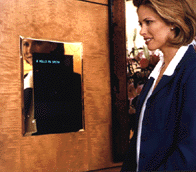 |
This is still a prototype suite for this 'High Tech' hotel.
In order to cater for more of this type of suites, the hotel
needs to pull in more fibre optical cables, raise the floors
and get an architect to redesign the spaces and perhaps the
entire the building. At the moment, this suite is enhanced with
all these high tech gadgets but its present structure and fixtures
might not be able to cope if 10% of the rooms were to be converted.
The hotel will need a bigger substation or generator and probably
a new air-conditioning system. Then, the room service and engineering
department would have to be expanded etc.
|
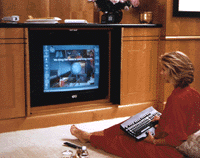 |
 |
Thus, the introduction of cyber technology into a physical
space is not a 'buy off the shelf' process. It requires re-engineering
the various aspects of architecture, if not the erection of
a completely new building.
|
4.3 Integration of Cyberspace into a Physical Space
As cyberspace and cyberian lifestyle only came about in the 1990s,
buildings and projects related to cyberspace is not many but they
are increasing in number. The reason is that more business organisations
are moving towards computerisation, therefore Cyberisation.
With increased exposure to cyberspace, the perception of the building
users is being tuned towards cyber-technology. Constant upgrading
and changing of parts become common activities. Thus architecture,
instead of creating something that is monumental and can withstand
the ageing of time, now deals with relatively more temporary and easily
reconfigurable. The city is seen as an immense node of communications,
a messy nexus of messages, storage and transportation facilities,
a massive education machine of its own complexity. Is idea of the
modern city is not new.
In the late 1960s, Archigram dreamt of a city that built itself unpredictably,
cybernetically, which did not resist television, telephones, air conditioning,
cars and advertising but accommodated and played with them made up
of inflatable buildings on rails, buildings like giant experimental
theatres with video cameras gliding like sharks through a sea of information
etc.
Although Archigram’s dream city did not become a reality, traces
of this city can be seen from some of recent projects.
GLASS VIDEO GALLERY
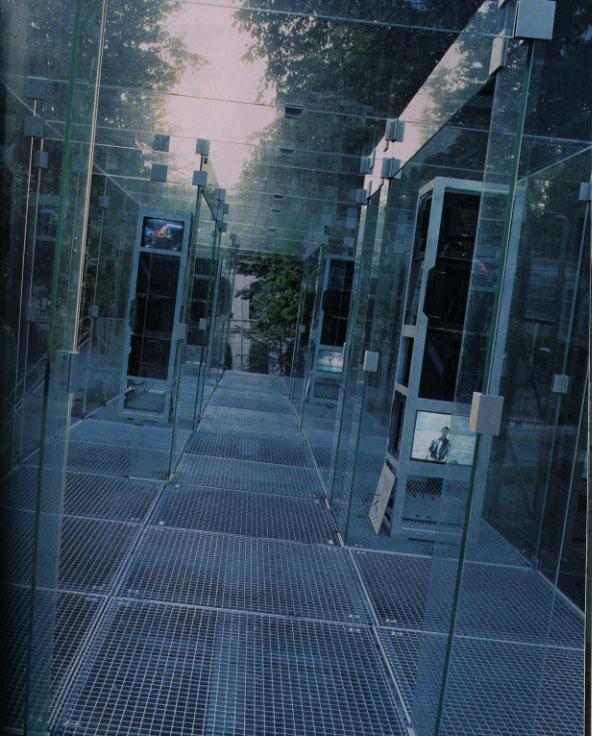
The Glass Video Gallery was commissioned by the city
of Groningen and the Groningen Museum as a public pavilion for watching
music videos. It is at the centre of a traffic roundabout. Within
the glass volume are six banks of video monitors. Tschumi's pellucid
structure signifies the immaterial nature of video images as flickering
patterns of coloured light projected onto a glass screen.
The elements of its architecture comprise of toughened glass plates
held by metal clips. The barrier between the inside and outside has
been minimised and thus enhanced the message of information bursting
out of the built form. Compared to a cinema that has a single window
looking outside, this idea is further multiplied by the multiple reflections
in the glass planes.
The lucid and rational function of glass as a building material is
ultimately denied by moving the gallery out of the cartesian grid
in which it would otherwise seem to belong and tilting it on two axes.
The glass volume of the gallery, the glass-screened video monitors
and video's function as in instrument of surveillance are all inverted.
The anonymous subjectivity of the visitor is rejected, instead, the
signified becomes also the signifier. The spectator becomes the subject.
The feasibility of private life in a media-suffused culture is being
questioned. At night, the architectural volume disappears and cyberspace
thus flows out into the surrounding that can be seen from reflections
picked up by shiny surfaces round.
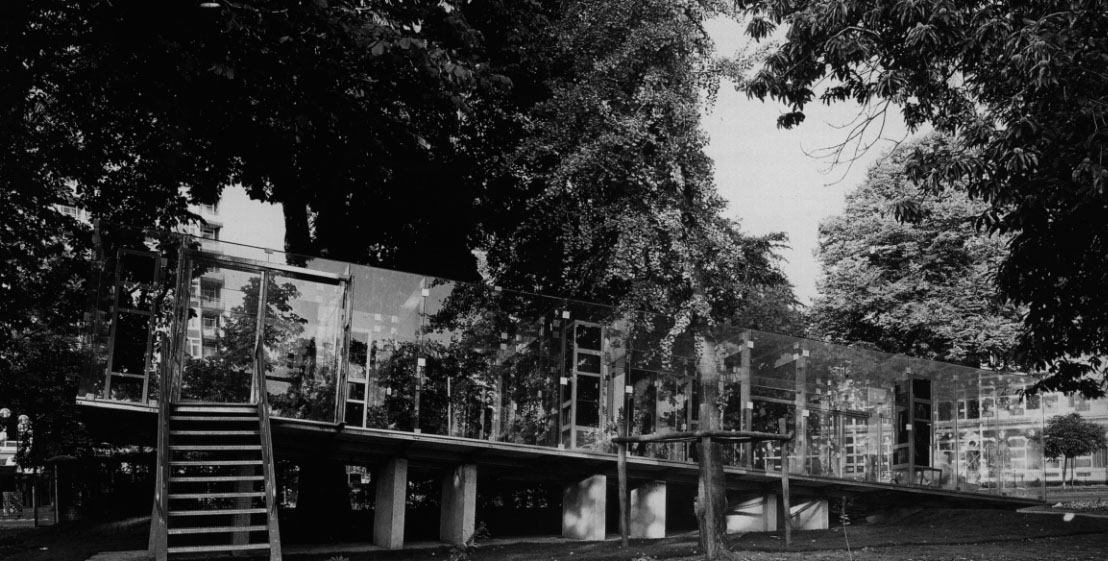
By using multi windows and multi channels in cyberspace,
the viewing of MTVs is changed. Architectural elements that use transparent
material like glass instead of solid walls. It allows the viewer to
choose and switch from one channel to the other.
The idea of universal accessibility in cyberspace is demonstrated.
In the night, the idea together with the sense of placelessness is
being emphasised by the sensuous floating TV screens.
The focus of the public towards cyberspace is translated into the
location, which is at the centre of a roundabout, enhancing the idea
of importance and significance.
By the use of materials and the layout of the elements, light from
the TV monitors shines out of the built form and is reflected onto
the surrounding. This is even more so at night. Thus, there is interaction
between the internal and the external, and an integration of the two
by multiple reflections, reflections of both internal and external
surfaces superimposed and reflected by another piece of glass, echoing
the success of the Internet that is about interaction.
D.E.SHAW AND COMPANY OFFICES IN NYC
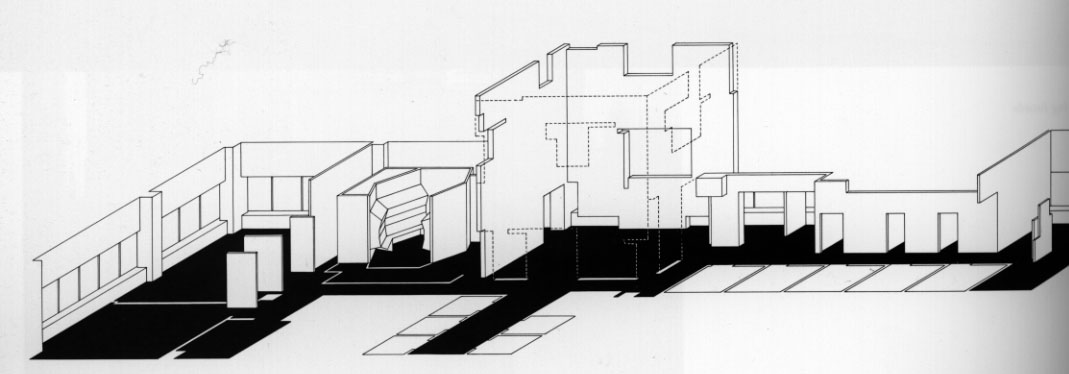
D.E. Shaw and company uses sophisticated mathematical
models running on Sun workstations to make high-volume trades in global
markets. Steven Holl was asked to design the office to create an environment
that represented the spirit of this high tech trading firm.
In this project, Holl used planes and the reflection of light as
a metaphor for reflection of information. Natural and artificial light
enters the space from concealed windows and fixtures, after being
reflected from surfaces painted in brilliant colours. The painted
colour surfaces are invisible and thus rendered mystical in its sourcelessness,
and the effect is of a cloistral anteroom to the realm of high finance.
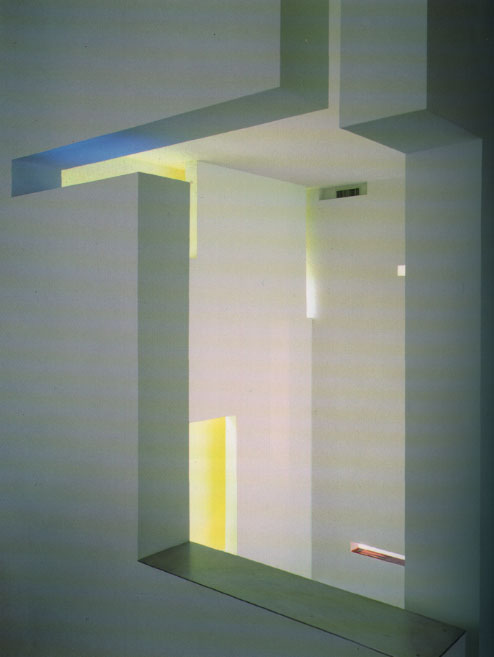
Holl's design uses light in some of its many manifestations.
He uses the projected diffuse colour to impart the intangible nature
of the client's business, which relies on computer links to telephone
lines and satellites.
....Here, behind a fluorescent green facade in the sky, computer
scientists and mathematicians monitor and respond day and night to
electronic transmissions of minutely fluctuating numbers...
In this project, Steven Holl used cyberspace as a metaphor in architecture
and thus combined both elements to produce a kind of cyber architecture.
 . .
continue
>
^
top
|








 .
.